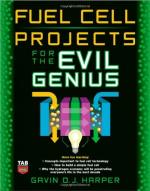|
This section contains 1,695 words (approx. 6 pages at 300 words per page) |

|
Fuel cells produce energy through electrochemical reactions rather than through the process of combustion. They convert hydrogen and oxygen into electricity and heat. Fuel cells are sometimes compared to batteries because, like batteries, they have two electrodes, an anode and a cathode, through which an electrical current flows into and out of the cell. But fuel cells are fundamentally different electrical devices from batteries since the latter simply store electrical energy, while the former are a source of electrical energy.
In a fuel cell, chemical energy is converted directly into electrical energy by means of an oxidation-reduction reaction. The British physicist Sir William Grove developed the fuel cell concept in 1839. A practical, working model of the concept was not constructed until a century later, however. The earliest fuel cells carried out this energy conversion by means of the reaction between hydrogen gas and oxygen gas, and...
|
This section contains 1,695 words (approx. 6 pages at 300 words per page) |

|


